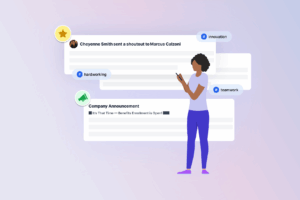Share
A workplace giving program can yield measurable ROI—reducing turnover rates and even increasing revenues—but some of the biggest advantages are less concrete: generating daily enthusiasm and rallying the company around a common cause. While addressing Corporate Social Responsibility (CSR) creates branding and sales opportunities for the company down the line, the most successful programs reflect the passions and values of employees—offering an instant impact internally. But before you can reap the internal benefits of a workplace giving program, what are the keys to creating a successful workplace giving program?
Get leadership buy-in
From the beginning, there needs to be a genuine commitment from company leadership. When employees are asked to make financial contributions, they need to believe that they’re contributing to a group effort much larger than their individual donations. One popular option is for employers to match employee donations. As with employees, managers should not be pressured into giving, but it’s helpful to find a cause that’s supported by the majority of the workforce, including management. When workflow allows, fully staffed companies might occasionally send employees to volunteer at community organizations on the clock, but financial contributions are far less complicated.
Develop a workplace giving program
Once you have one or more worthy causes, you need a sustainable way to support those organizations. Some employees may be willing to volunteer their time, but the easiest way to include your entire workforce is a workplace giving program, which is an easy, efficient way for employers and employees to align on charitable giving through automatic payroll deductions.
With a flexible program like Helping Hands from Netchex, employees can make one-time, staggered, or recurring paycheck deductions as part of a company-wide charitable campaign—with employer match options available. Administrators can create and track a single or multiple campaigns with timelines, goals, and up-to-the-minute donations, as well as campaign history, past campaigns, and more.
Research charities and provide options
Some nonprofits have been around longer than others. Some have higher overhead expenses. Some get too much attention, while others go underserved. Most importantly, make sure to research your preferred charitable organizations and how they allocate donated funds.
As workplace giving becomes a long term feature of your company, you’ll want to have different options for employees with different priorities. Some of the employees enthusiastic about the local animal shelter may not be interested in working with Habitat for Humanity over the weekend. Some may be more passionate about social justice and equality. When you have options, get employee input on the causes and organizations they would be more interested in supporting.
Make charitable giving a part of company culture
Whether your charitable organization is international or community-based, there should be opportunities to support that organization and raise its visibility in your own region. Depending on your industry, you may be able to make in-kind donations and provide relevant services at minimal cost. Ultimately, your support for the organization should go beyond the occasional bank transfer, becoming an extension of your company culture.
Fundraising goals and achievements, as well as current projects of your chosen organization, can be highlighted in company meetings and other times when all employees are gathered together. As your company becomes more connected in supporting the chosen organization, your more skeptical employees will see that the company is committed to having a positive impact, not just experimenting with alternative marketing strategies.
Drive employee engagement
The enthusiasm and engagement of your employees will make a huge difference in the success of any workplace giving program. Once you’ve chosen a popular cause that a majority of staff are interested in supporting, you’ll need to provide different levels of participation for employees to choose. Not everyone has the same amount of disposable income or free time, but employees who only donate a dollar a month are still participating in the group effort. Rather than focusing exclusively on raising as much money as possible, try to get as many employees as possible involved in the effort, even if the individual donations are small.
Gather feedback internally and externally
You may have used a committee or surveys to outline your workplace giving program, but it’s important to check in again with employees and seek additional feedback. Even fans of the chosen organization may prefer different methods of showing their support. Depending on how the program is introduced company-wide, there will be a variety of opinions and responses to consider. Instead of feeling discouraged by critical responses, look for ways to encourage the skeptics to take a more active role in improving the program. Leverage the charitable cause as a team building opportunity, building cooperation between departments and individuals who rarely collaborate in daily work.
Incorporate Your Giving into Recruiting and Sales Material
Once you’ve found a sustainable way of supporting a nonprofit, and you’ve confirmed that employees have more than a short term interest in the project, it’s time to make the commitment public. Use your social media channels and company blog to broadcast your progress toward goals. When your charitable giving is featured in recruiting materials, you’ll attract more motivated and conscientious applicants for new positions. A company that not only supports charitable giving, but makes it a priority will always be a great place to work.
For a workplace giving program that adapts to a wide range of styles and projects, check out our new Helping Hands feature:
Related articles

Introducing HR Reporting with AI that Can Actually Impact Your Bottom Line

The Real ROI of Streamlining HR and Payroll

Tasks & Workflows: Innovating Automation for HR

